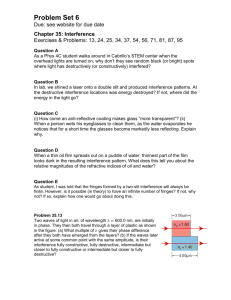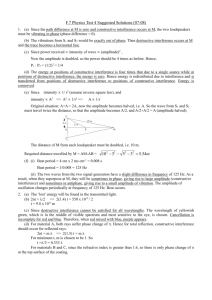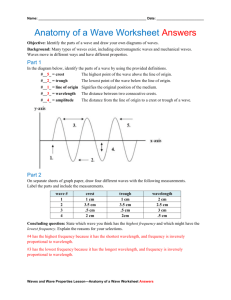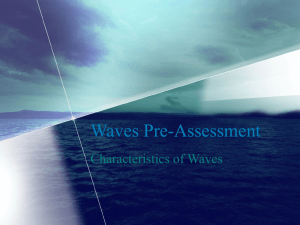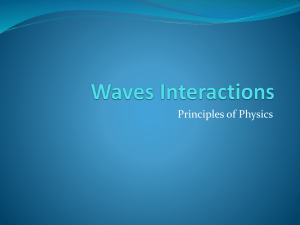A Simple Introduction to Interference First, consider two wave pulses
advertisement
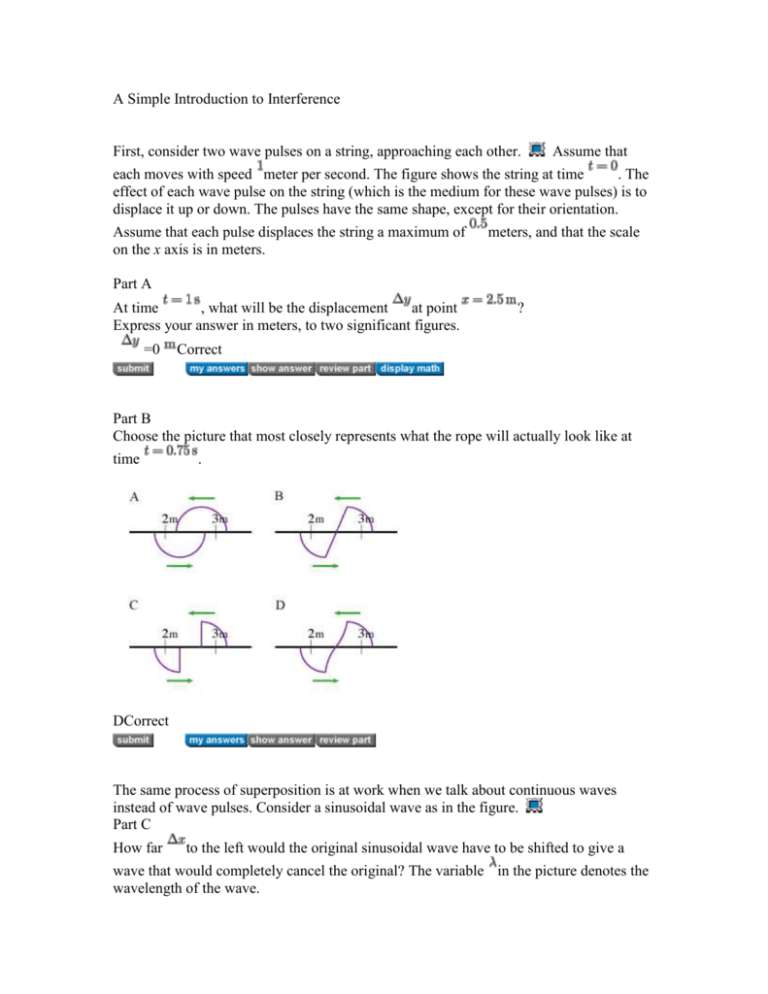
A Simple Introduction to Interference First, consider two wave pulses on a string, approaching each other. Assume that each moves with speed meter per second. The figure shows the string at time . The effect of each wave pulse on the string (which is the medium for these wave pulses) is to displace it up or down. The pulses have the same shape, except for their orientation. Assume that each pulse displaces the string a maximum of on the x axis is in meters. meters, and that the scale Part A At time , what will be the displacement at point Express your answer in meters, to two significant figures. =0 ? Correct Part B Choose the picture that most closely represents what the rope will actually look like at time . DCorrect The same process of superposition is at work when we talk about continuous waves instead of wave pulses. Consider a sinusoidal wave as in the figure. Part C How far to the left would the original sinusoidal wave have to be shifted to give a wave that would completely cancel the original? The variable in the picture denotes the wavelength of the wave. Express your answer in terms of . =0.5*lambdaCorrect Part D In talking about interference, particularly with light, you will most likely speak in terms of phase differences, as well as wavelength differences. In the mathematical description of a sine wave, the phase corresponds to the argument of the sine function. For example, in the function , the value of at a particular point is the phase of the wave at that point. Recall that in radians a full cycle (or a full circle) corresponds to How many radians would the shift of half a wavelength from the previous part correspond to? Express your answer in terms of . phase difference =pi radiansCorrect radians. Part E The phase difference of radians that you found in the previous part provides a criterion for destructive interference. What phase difference corresponds to completely constructive interference (i.e., the original wave and the shifted wave coincide at all points)? Express your answer as a number in the interval phase difference =0 radiansCorrect . Part F Since sinusoidal waves are cyclical, a particular phase difference between two waves is identical to that phase difference plus a cycle. For example, if two waves have a phase difference of , the interference effects would be the same as if the two waves had a phase difference of . The complete criterion for constructive interference between two waves is therefore written as follows: Write the full criterion for destructive interference between two waves. Express your answer in terms of and . phase difference =pi+pi*2*n Correct The phase for a plane wave is a somewhat complicated expression that depends on both position and time. For most interference problems, you will work at a specific time and with coherent light sources, so that only geometric considerations are relevant. Consider two light rays propagating from point A to point B in the figure, which are ray follows a straight path, and the other travels at a apart. One angle to that path and then reflects off a plane surface to point B. Both rays have wavelength . Part G Find the phase difference between these two rays at point B. Express your answer in terms of . phase difference =3*pi/2 radiansCorrect Part H Suppose that the reflected ray receives an extra half-cycle phase shift when it reflects. What is the new phase shift at point B? Express your answer in terms of . phase difference =5*pi/2 radiansCorrect Whenever light reflects from a transparent interface, moving from lower index of refraction to higher index of refraction, it gets an extra half cycle phase difference. Being able to accurately find the phase differences between waves at various points will be useful in both interference and diffraction problems. Why Butterfly Wings Shimmer Part A Assume that light is incident normal to the surface of a film of thickness . How much farther does the light reflected from the back surface travel than the light reflected from the front surface? Express your answer in terms of . 2*dCorrect Part B For constructive interference to occur, the difference between the two paths must be an integer multiple of the wavelength of the light (as is true in any interference problem), i.e. the general criterion for constructive interference is , where is a positive integer. This is usually stated in the slightly more explicit form . Given the thickness of the film , what is the longest wavelength that can exhibit constructive interference? Express your answer in terms of . =2*dCorrect Part C If you have a thin film of thickness , what is the third-longest wavelength of light that exhibits constructive interference with the reflected light? Note that this corresponds to . Express your answer in nanometers to three significant figures. =200 Correct Part D The criterion for destructive interference is very similar to the criterion for constructive interference. For destructive interference to occur, the difference between the two paths must be some integer number of wavelengths plus half a wavelength: , or , where is a nonnegative integer. What is the second-longest wavelength that will not be visible (i.e., will have strong destructive interference for the reflected waves) when reflected from a film of thickness ? Note that the longest wavelength corresponds to for destructive interference. This is why the notation used for the second-longest wavelength is instead of . Express your answer in nanometers to three significant figures. =400.0Correct The blue morpho butterfly lives in tropical rainforests and can have a wingspan greater than 15 centimeters. The brilliant blue color of its wings is a result of thin-film interference. A pigment would not produce such vibrant, pure colors. What cannot be conveyed by a picture is that the colors vary with the viewing angle, which causes the shimmering iridescence of the actual butterfly. The scales of the butterfly's wings consist of two thin layers of keratin (a transparent substance with index of refraction greater than one), separated by a 200-nanometer gap filled with air. Part E What wavelength of light would be strongly reflected at normal incidence? The keratin layers are thin enough that you can think of them simply as marking the surfaces of a 200-nanometer "film" of air. Express your answer in nanometers to two significant figures. =400 Correct This wavelength is near the cutoff between visible (violet) and ultraviolet light, so the shorter wavelengths that are strongly reflected will not be relevant to what humans see when they look at the butterfly. To understand why the color changes with viewing angle, try drawing a diagram of light incident on a thin film at a large angle. The distance within the film will be increased, but the light reflected from the front surface will have to travel further to the observer outside of the film than the light reflected from the back surface. The increased distance outside of the material for the front surface reflection actually makes the net path-length difference smaller than it would be for normal incidence. As viewing angle increases, the largest wavelength that experiences constructive interference gets shorter. Thus, while the butterfly is blue at normal incidence, at large angle of incidence no visible light is short enough wavelength to be strongly reflected. Part F The wavelength that we have been discussing is technically the wavelength of light within the medium of the film. It is important to remember this, since most thin-film problems will involve films with index of refraction different from that of air. Suppose that the butterfly gets wet, thus filling the gaps between the keratin sheets with water ( ). What wavelength in air will be strongly reflected now? Note that the wavelength within the film was already determined in the previous problem. Express your answer in nanometers to two significant figures. =530 Correct Part G Several thin films are stacked together in each butterfly wing scale. How would these multiple layers of thin films affect the light reflected by the butterfly's wings? More 400-nanometer light would be reflected, because some of the light transmitted through the first layer could be reflected by the second layer, light transmitted by the second layer could be reflected by the third, etc. Correct Layering of thin films is used to make wavelength-specific mirrors, used widely in laser applications, that are far more reflective than metal mirrors. Layered films are also used to make antireflective coatings for camera lenses.

